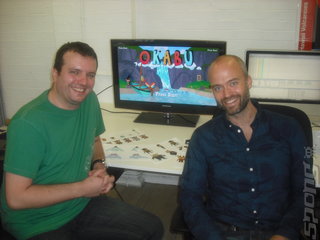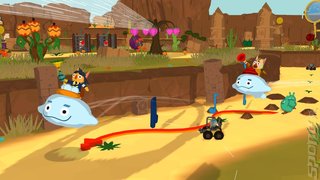Imagine a couple of whale-shaped clouds spitting fountains of water onto pollution-bent robots, against a colourful backdrop that wouldn’t look out of place on a CBeebies programme.
That’s the wacky world of Okabu, a PlayStation Network title developed by successful iOS indie studio HandCircus. But don’t let its sickeningly cute presentation deceive you - underneath the primary colours and smile-inducing rhythmic soundtrack lies a rather enchanting gameplay experience.
You control one of two gurning clouds, Kumulo and Nimbe, as they protect the Yorubo tribe from the threat of industrialisation by the nasty Doza clan. It’s an environmental story inspired by the likes of animated films such as Princess Mononoke.
HandCircus founder Simon Oliver doesn’t credit Japanese anime for the colourful art style of Okabu though - something a little closer to Scandinavia. “Mikko Walamies, our concept artist who created the illustrations and designs, is from Finland. The land of the Moomins! So everything’s naturally cute. We wanted to create a world that people just fell in love with, to explore and discover.”
It was a philosophy that resonated well with Sony, Simon adds, as the company’s Worldwide Studios arm quickly offered to help support the game through its exclusive Pub Fund initiative. Sony and HandCircus were a perfect fit: “After [iOS titles] Rolando and Rolando 2 we had a lot of doors open to us, based on those games’ successes. Moving onto console felt like a really good move for us - and Sony was really responsive out of all the companies we showed Okabu to.”
Going from humble beginnings as an unknown developer for Apple’s iPhone to a platform shared with games like Flower and the PixelJunk series was an exciting prospect. “They have a good attitude to trying to promote interesting titles, and to use PSN to build a home for more distinctive titles. It gives gamers an opportunity to try new experiences. Sony felt like a perfect partner because of that.”
The beauty is in the simplicity of the gameplay as well - using the left analogue stick to swoop around trees, villages and farms is satisfying enough, but your ability to tackle the raging pollution in the forest comes from picking up various ‘heroes’ in the stage and using their unique skills to solve puzzles.
Piccolo has a flute which can direct animals and NPCs, and there are different uses for each creature. Bulls can be used to smash barriers and attack enemies, baby chicks can eat certain plants so you can progress, and Yorubo tribesmen can help farm crops, operate machinery and press buttons for you.
Other heroes that can ride on your back include Roki, a Doza defector that can take advantage of machinery and remote controlled robots to do your bidding; and a fisherman called Captain Monkfish (easily the best name I’ve ever seen in a game to date), whose plunger gun can help open chests, doors and other obstacles.
You’re always in control of Kumulo and Nimbe throughout the stage, whether you’re playing single-player or the two player co-operative mode. Pressing Triangle in single-player allows you to switch between the two clouds, which is handy because this way you can have two heroes at your fingertips at any one time.
Certainly there’s room for complexities, but everything in Okabu is controlled with one or two face buttons and the left stick. Simon said that the original control scheme for the game was really quite complicated, and as development progressed the team was able to chip away at unnecessary functions. “Initially it wasn’t a co-op game to start with, it was single player with twin sticks, loads of buttons.
“There was this really weird control system we had at first which had altitude controls on the right stick, and there was lock-on functions. Really strange behaviours - but every couple of weeks we’d get rid of another button, and get rid of another button... What we want to do is create something that still has the depth and richness that players are looking for that, but at the same time it’s easy to pick up and easy to play without needing to put a lot of barriers in the way.”
That’s the wacky world of Okabu, a PlayStation Network title developed by successful iOS indie studio HandCircus. But don’t let its sickeningly cute presentation deceive you - underneath the primary colours and smile-inducing rhythmic soundtrack lies a rather enchanting gameplay experience.
You control one of two gurning clouds, Kumulo and Nimbe, as they protect the Yorubo tribe from the threat of industrialisation by the nasty Doza clan. It’s an environmental story inspired by the likes of animated films such as Princess Mononoke.
HandCircus founder Simon Oliver doesn’t credit Japanese anime for the colourful art style of Okabu though - something a little closer to Scandinavia. “Mikko Walamies, our concept artist who created the illustrations and designs, is from Finland. The land of the Moomins! So everything’s naturally cute. We wanted to create a world that people just fell in love with, to explore and discover.”
It was a philosophy that resonated well with Sony, Simon adds, as the company’s Worldwide Studios arm quickly offered to help support the game through its exclusive Pub Fund initiative. Sony and HandCircus were a perfect fit: “After [iOS titles] Rolando and Rolando 2 we had a lot of doors open to us, based on those games’ successes. Moving onto console felt like a really good move for us - and Sony was really responsive out of all the companies we showed Okabu to.”
Going from humble beginnings as an unknown developer for Apple’s iPhone to a platform shared with games like Flower and the PixelJunk series was an exciting prospect. “They have a good attitude to trying to promote interesting titles, and to use PSN to build a home for more distinctive titles. It gives gamers an opportunity to try new experiences. Sony felt like a perfect partner because of that.”
The beauty is in the simplicity of the gameplay as well - using the left analogue stick to swoop around trees, villages and farms is satisfying enough, but your ability to tackle the raging pollution in the forest comes from picking up various ‘heroes’ in the stage and using their unique skills to solve puzzles.
Piccolo has a flute which can direct animals and NPCs, and there are different uses for each creature. Bulls can be used to smash barriers and attack enemies, baby chicks can eat certain plants so you can progress, and Yorubo tribesmen can help farm crops, operate machinery and press buttons for you.
Other heroes that can ride on your back include Roki, a Doza defector that can take advantage of machinery and remote controlled robots to do your bidding; and a fisherman called Captain Monkfish (easily the best name I’ve ever seen in a game to date), whose plunger gun can help open chests, doors and other obstacles.
You’re always in control of Kumulo and Nimbe throughout the stage, whether you’re playing single-player or the two player co-operative mode. Pressing Triangle in single-player allows you to switch between the two clouds, which is handy because this way you can have two heroes at your fingertips at any one time.
Certainly there’s room for complexities, but everything in Okabu is controlled with one or two face buttons and the left stick. Simon said that the original control scheme for the game was really quite complicated, and as development progressed the team was able to chip away at unnecessary functions. “Initially it wasn’t a co-op game to start with, it was single player with twin sticks, loads of buttons.
“There was this really weird control system we had at first which had altitude controls on the right stick, and there was lock-on functions. Really strange behaviours - but every couple of weeks we’d get rid of another button, and get rid of another button... What we want to do is create something that still has the depth and richness that players are looking for that, but at the same time it’s easy to pick up and easy to play without needing to put a lot of barriers in the way.”




